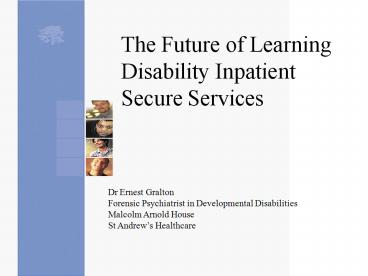The Future of Learning Disability Inpatient Secure Services - PowerPoint PPT Presentation
1 / 22
Title:
The Future of Learning Disability Inpatient Secure Services
Description:
Head injury amongst referral ... Often complicated by other psychiatric disorders ... Beagles & rats exposed to electric shock without chance to escape ... – PowerPoint PPT presentation
Number of Views:97
Avg rating:3.0/5.0
Title: The Future of Learning Disability Inpatient Secure Services
1
The Future of Learning Disability Inpatient
Secure Services
Dr Ernest Gralton Forensic Psychiatrist in
Developmental Disabilities Malcolm Arnold
House St Andrews Healthcare
2
Key issues- we need to adapt to new evidence
- Complex co-morbidities
- Head injury
- Complex co-morbid Autism/DAMP
- Developmental Traumatology
- Rehabilitation systems/philosophy
- Right brain treatments
- Diet
- Touch
- Exercise
- Pharmacology
3
Complex and Diverse population
- Autistic Spectrum Disorders
- DAMP
- Tourettes Disorder
- PTSD Developmental Trauma
- Affective Disorders (atypical)
- Schizophrenia/Schizoaffective
- Attachment disorders
- Paraphillias
- Brain injury/Executive function deficits
- Conduct Disorder
- Substance misuse
4
Head injury
- Head injury amongst referral population common
- In a significant minority- developmentally normal
prior to serious head injury - Often complicated by other psychiatric disorders
- Requires neuro-psychology input with brain injury
expertise - Can lead to a range of offending behaviours
including serious sexual offending- executive
function deficits
5
Attachment issues/Developmental Traumatology
- High levels of disordered attachment
- Increased levels of neglect and abuse
- Early entry into care
- Multiple short term failed placements
6
Animal models
- Seligman
- Learned Helplessness 1967
- Beagles rats exposed to electric shock without
chance to escape - Originally considered a model for depression now
more likely for PTSD (especially Chronic PTSD) - Massive outpourings of stress neurohormones
- Animals exposed to varieties of chronic stress
(including primates)- demonstrate impairments in
learning and memory - Associated with alterations in structure-
temporal lobe, amygdala and hippocampus
7
Anxiety Bell Curve
- Anxiety increases to a level where performance
decreases - Speech centres shut down, increased blood flow
motor areas - Over-arousal can quickly lead to aggression
8
Stress Plasticity in Limbic System (Sapolsky
2003)
- Damage by Glucocorticoids-
- Decrease in length retraction of dendritic
processes - Loss of branch points, neuronal atrophy/death
- Growth is promoted (rodents/primates)
- a) Reduction in glucocorticoids (stress)
- b) Environmental enrichment
- c) Exercise
9
(No Transcript)
10
Autism
- A high proportion of young people with LD
requiring inpatient care have co-morbid autism - Dislike change, find transitions very difficult
11
Mixed Disorders
- Symptoms of ADHD 1846
- Comorbid disorders
- DAMP syndrome
12
Sensory Sensitivities
- Significant proportion of autistic patients have
sensory sensitivities- that may adversely
influence behaviour
13
Robert
- 17 year old adolescent in mild LD range
- Developmental History consistent with PDD/ADHD/
Developmental dyspraxia - Aggressive toward sibs- punitive parenting
strategies - Multiple foster care placements from age 4
- Sexual abuse history from age 7, head injury aged
8 - Erratic education/ no peer relationships bullied
- Multiple childrens homes from age 9
- Arson and sexual offending against younger
children - Social Services Secure Accommodation-
consistently aggressive, needing continuous
restraint
14
Care Pathway
- Conventional mental health rehabilitation
pathway models are often unsuitable
15
The developmental perspective
- Young people still rapidly developing
- Challenges- more complex difficult to meet
needs - Opportunity- to make a much greater impact on
their development and outcome - Unlikely single interventions will be sufficient
- Programme of intervention should be comprehensive
covering all developmental domains - Improvements in one area impact on others
- More difficult to distinguish contribution of
individual interventions
16
Hierarchy of interventions
- They need to be safe basic needs met
- Level of arousal/aggression needs to be reduced
- Only then can move on to other interventions
- Every interaction has the potential to be
therapeutic
17
EMDR
- Number of theories as to mechanism of effect
- Difference between hippocampal/amygdala may
initially worsen PTSD and lead to increased risk
of self harm - neocortical memories- conversion one to other
- Good evidence for single trauma PTSD in adults
- Delivering it to patients (especially
adolescents) with complex PTSD is not straight
forward - If dissociate cannot co-operate with procedure
- Highly reliant on feedback of SUD score
- Needs to be supported with other anxiety
management techniques and medication
18
Neurobiology of EMDR
- EMDR stimulation (visual, auditory and tactile)
brings about a constant alternating shifting of
attention- cholinergic surge. - The cholinergic surge starts the REM processing
system. - Pontine Genticulate Occipital (PGO) Waves occur
in REM EMDR - The REM system activates areas of the anterior
cingulate, - link between (cognitive) neocortex
and (emotional) limbic areas - facilitating the
integration of traumatic memory into neocortex. - Inhibition of both hippocampal episodic memories
amygdaloid mediated negative affect of PTSD.
19
Solution Focused Model
- Widely used individual intervention for
difficult to treat populations -good evidence
efficacy - Widened use into a Model of Care
- Crosses multi-professional boundaries
- Simple principles easy to teach- quick to apply
- Integrates with CPA
- Future focussed- acknowledges individual
preferred future - Draws on existing strengths
- Avoids confrontational relationships
20
Diet
20 of neuronal wall is made up of Essential
Fatty acids DHA is essential for the operation of
ion channels Essential for neuronal growth
21
Pharmacotherapy
- Low dose Risperidone for CD/LD/Autism
- SSRI- act via serotonergic mechanisms, can
trigger rapid cycling affective disorders - Benzodiazepines- can increase dissociation
- Antiepileptics- Carbemazepine and Valproate open
label evidence - Antiadrenergic agents Propranolol Clonidine (NIMH
CT trial underway)
22
Be prepared!
- Young people need lots of preparation to make a
transition into a new placement































